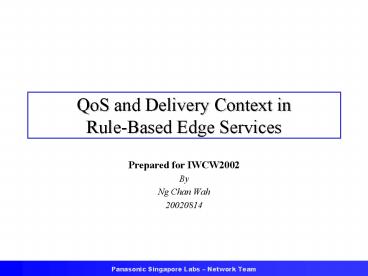QoS and Delivery Context in RuleBased Edge Services - PowerPoint PPT Presentation
1 / 20
Title:
QoS and Delivery Context in RuleBased Edge Services
Description:
Panasonic Singapore Labs Network Team. QoS and Delivery Context in. Rule-Based Edge Services ... Panasonic Singapore Labs Network Team. Deployment ... – PowerPoint PPT presentation
Number of Views:41
Avg rating:3.0/5.0
Title: QoS and Delivery Context in RuleBased Edge Services
1
QoS and Delivery Context in Rule-Based Edge
Services
- Prepared for IWCW2002
- By
- Ng Chan Wah
- 20020814
2
Agenda
- Rule-Based Services in the Edge
- Open Pluggable Edge Services
- Need for QoS and Delivery Context
- Implementations
3
In the Core
- Various different content formats are emerging
WML
Real
Flash
PNG
GIF
DHTML
HTML
ASP
MPEG1
Quicktime
Windows Media
JPEG
PHP
MPEG4
4
At the Edge
- Various different user agents and platforms are
emerging
5
Enter Edge Services
- To efficiently deliver contents of various
formats to the end users with various agents and
platforms - With 3 main types of edge services
- Adapts the requests
- Adapts the response
- Dynamically assemble the contents
6
Open Pluggable Edge Services
- Current effort by the IETF OPES WG
- Architecture
7
Example Services of OPES
8
But
- IRML constructs rules based on properties in
HTTP headers - Such as Content-Type, User-Agent
- Limited information conveyed
- Especially profound for wireless web
9
Why?
- Wireless Environment
- Bandwidth is expensive
- QoS is important consideration
- Mobile Environment
- Wide diversity in devices types, screen sizes
- Battery constraints client-side services is not
a good ides
10
Extending OPES
- Sub-System mechanism
- extend properties that Rule Engine understand
beyond HTTP headers
11
Extending OPES
- QoS Sub-System
- Interprets QoS and network conditions
- Such as bandwidth-available, bytes-transmitted
12
Extending OPES
- Delivery Context Sub-System
- Interprets Delivery Context
- Such as User Preferences, Agent and Device
Capabilities, and Natural Environment
13
Implementation
to other collaborating caches
Caching Proxy
Adaptation Services
Traffic Control Framework
Rule Engine
to content servers
to wireless clients
QoS Sub-System
Delivery Context Sub-System
Remote Adaptation Services
Delivery Context Database
14
Implementation
to other collaborating caches
Caching Proxy
Adaptation Services
Traffic Control Framework
Rule Engine
to content servers
to wireless clients
QoS Sub-System
Delivery Context Sub-System
Remote Adaptation Services
Delivery Context Database
15
Implementation
to other collaborating caches
Caching Proxy
Adaptation Services
Traffic Control Framework
Rule Engine
to content servers
to wireless clients
QoS Sub-System
Delivery Context Sub-System
Traffic Control Framework monitors and condition
packets flowing into the network
Remote Adaptation Services
Delivery Context Database
16
Implementation
to other collaborating caches
Caching Proxy
Adaptation Services
Traffic Control Framework
Rule Engine
to content servers
to wireless clients
QoS Sub-System
Delivery Context Sub-System
QoS Sub-System obtain values for QoS properties
in IRML by interfacing with the Traffic Control
Framework
Remote Adaptation Services
Delivery Context Database
17
Implementation
to other collaborating caches
Caching Proxy
Adaptation Services
Traffic Control Framework
Rule Engine
to content servers
to wireless clients
QoS Sub-System
Delivery Context Sub-System
In the actual system, the Delivery Context
Sub-System should obtain values for delivery
context from an external database, but currently
is not implemented. Delivery Context information
are now embedded in the HTTP headers.
Remote Adaptation Services
Delivery Context Database
18
Deployment
- Conversion of Images to Text
- Bandwidth available
- Screen capability
- User Preference
19
Deployment
- Conversion of Audio-Visual Streams
- Bandwidth available
- Screen capability
- User Preference
20
Summary
- OPES as a standardized, rule-based framework for
edge services - Extend OPES to understand QoS and Delivery
Context - Implementation Examples
- Questions?































